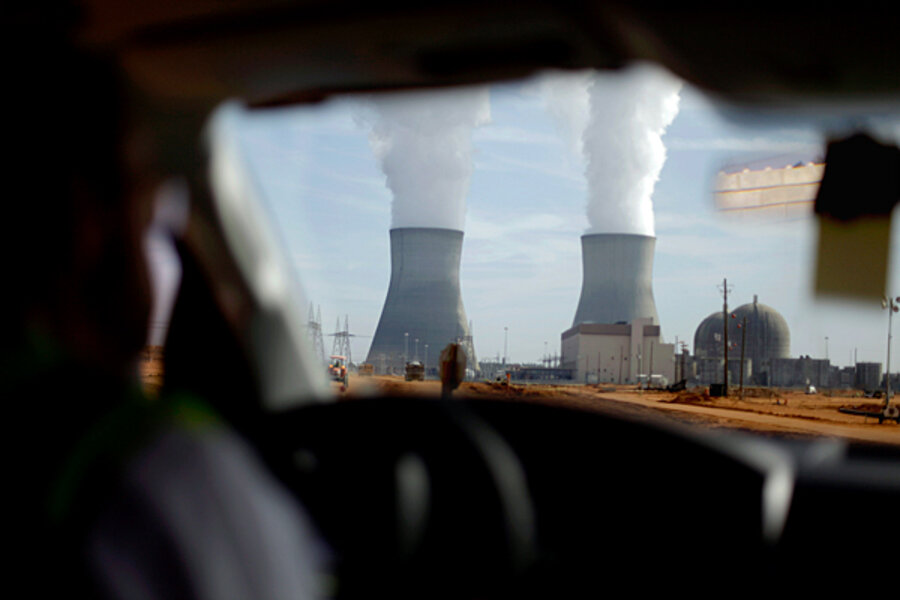Year after Fukushima, US plodding on nuclear plant fixes, watchdog says
Federal regulators are not moving swiftly enough to safeguard the nation's nuclear power fleet from catastrophic accidents like the one at Fukushima Japan, according to a nuclear power industry watchdog that also slams the industry for seeking a quick cheap fix for safety.
The Nuclear Regulatory Commission deserves praise for its swift action to diagnose needed upgrades in US nuclear plants in the days and weeks after the March 11, 2011 meltdowns at Fukushima, says a major new report by the Union of Concerned Scientists (UCS).
But the study hammers the agency for plodding on implementing key recommendations the agency’s own task force delivered last summer – and criticizes the nuclear power industry for leaping to install weaker, less costly safety measures in the absence of a federal mandate.
“The NRC took 10 years to fully implement new security measures in response to the 9/11 terrorist attacks, and now it says it will take at least five years to implement post-Fukushima reforms,” Edwin Lyman, a report co-author and a physicist with UCS’s Global Security Program, said in a statement. “Meanwhile, the industry has bought hundreds of pieces of off-the-shelf emergency equipment that may end up on the junk pile if it doesn’t ultimately meet the requirements that the NRC has yet to develop.”
A year ago, lacking cooling water circulation from pumps, the cores of three of six reactors at Daiichi soon began to melt down. Radiation spewed into the atmosphere, onto adjacent land and into the ocean. Today, long after the reactors achieved “cold shutdown,” the region within 12 miles of the Fukushima site is so contaminated by radioactive isotopes that the roughly 80,000 people who lived there are unable to return to their homes. Hot spots up to 25 miles distant from the plant site are still uninhabitable.
The UCS reports commended the NRC's action to recommend Americans remain 50 miles away from the Daiichi complex, despite little information at the time.
“The initial response of the US Nuclear Regulatory Commission (NRC) to the Fukushima tragedy was commendable,” the report authors write. “As the disaster evolved, the agency fielded a large number of inquiries – such as from the media, the American public, and Capitol Hill – in a timely and responsive manner.”
There are now 23 nuclear reactors in the US with designs similar to the Daiichi plant. While most US reactors may not be vulnerable to Daiichi's sequence of earthquake followed by tsunami, “ they are vulnerable to other severe natural disasters,” the report says. “Similarly serious conditions could be created by a terrorist attack.”
Since the disaster in Japan, the NRC has received a list of recommendations – but has so far done little to implement them, indicating a timeline that could take five years or more.
Among problems yet to be addressed, the UCS report says, is lack of disaster-proof instrumentation. Like the Fukushima plant, “most US reactors also lack instrumentation that would allow operators in the control room to monitor key parameters, such as the level and temperature of the water in the spent fuel pools.
“In Japan and the United States alike, the possibility of an accident affecting more than one reactor at a multi-unit site has simply been ignored in present accident mitigation and emergency response strategies,” the report found. “While US reactors, like Japanese reactors, are required to have plans to cope with a station blackout, these plans would have been useless under the conditions experienced at Fukushima.”
The UCS report also finds that:
• The NRC has relegated the No. 1 recommendation of its Fukushima task force – to clarify the agency's “patchwork” regulatory framework for severe (“beyond-design-basis”) accidents such as the one at Fukushima – to last in line to be dealt with.
• The NRC is now proposing that licensees provide “reasonable protection” for emergency equipment, but has not yet defined how such a requirement could be met or how “hardened” the equipment should be – producing what the UCS calls a “policy gap.”
• The nuclear power industry is rushing into the “policy gap” by purchasing additional mobile diesel powered pumps and other emergency equipment, but without NRC guidance on how robust and “hardened” it should be.
• Three key emergency steps selected for evaluation by the task force have been put on back burner: enlarging emergency evacuation zones, expanding potassium iodide distribution, and speeding up the transfer of spent fuel from pools to dry casks.
“The NRC has put the cart before the horse by not addressing its task force’s primary recommendation before doing anything else,” said Dave Lochbaum, director of the UCS Nuclear Safety Program said in a prepared statement. “By putting it off, the agency has potentially undermined the effectiveness of the other recommendations, which all hinge on this critical issue.”
Officials at the NRC say the criticisms are premature.
“The NRC has diligently and efficiently worked on implementing the most important of the agency’s Near-Term Task Force recommendations,” writes Scott Burnell, an NRC spokesman in an e-mailed statement. “Issuing rushed, incomplete requirements would waste both the NRC’s and the industry’s resources and complicate the overall goal of enhancing US reactor safety.”
Nuclear industry officials say they are doing the right thing whatever the NRC may determine in the future. At a press conference that preceded the UCS report release, the Nuclear Energy Institute said its new FLEX plan to deploy new emergency equipment to sites near nuclear plants will address many if not most Fukushima concerns in the interim while the NRC is working on its final requirements.
“We have worked proactively almost from the moment the tsunami struck Japan to capture and apply lessons learned,” said Charles Pardee, chairman of the nuclear industry's Fukushima Response Steering Committee and chief operating officer for Exelon Generation Co., a major nuclear power utility company. “The FLEX strategy is a tangible byproduct of this ongoing effort.”






